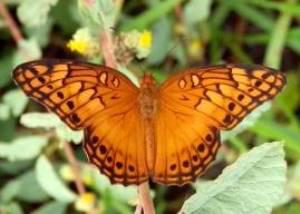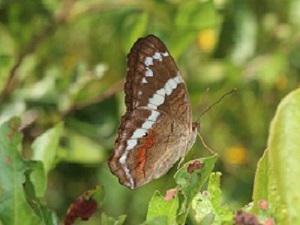Jose I. Martinez
The aim is to contribute to knowledge of the biology and requirements of butterflies and moths, increase faunal lists of Yalahau Park for future conservation plans.

Variegated Fritillary.
Yalahau Lagoons State Park, Homun, Yucatan is considered a priority site for the conservation of flora and fauna biodiversity. Comprising a important series of continental wetlands, permanent freshwater, ponds, marshes and swamps, among these 4 lagoons and 203 cenotes; a natural deep underground water reservoirs typical of the karstic systems of the Yucatan Peninsula. Yalahau Lagoons presents deciduous dry forest, floodplain forest, tulares and transitional vegetation. There are species that are under some protection status and also endemic species to the Yucatan Peninsula. However, biodiversity studies in this area are lack and most of these works have been performed only with plants and macrofauna, forgetting small species such as arthropods and insects, which play an important role in the ecosystem.

Banded Peacock.
Butterflies and moths are linked with plants and other organisms (predators and parasitoids) as a result of co-evolution even more, butterflies and moths are too sensitive to change of ecosystems and environments as a consequence of their specific requirements. This project will be the first study of diversity and conservation of Lepidoptera in Yucatan.
We will be determinate species richness, abundance and diversity of Lepidoptera communities and collect information about the environment and type of vegetation that species prefer. The information generated will contribute directly to increase the number of species reported in the faunal list of Yalahau Park and indirectly to the knowledge of the Lepidoptera of Yucatan. Also the results obtained in the project could be use and include in future management’s plans and it will serve to develop monitoring programs in the reserve.
A systematic sampling of lepidopteran will conducted throughout the Yalahau Lagoon State Park. For caterpillars, we will follow the life cycle, taking photos of each stage and growing them until adults, as in this stage the identification is easier. Repeated species will be freed in the same area where it was collected. The species identification will be made through specialized books and with the support of experts to corroborate identifications. Adult specimens collected will be kept in entomological boxes and larvae remain in alcohol for future reference. Also we will edit the photograph catalogue and the website which will be reviewed by experts. Besides specimens collected will contribute to the creation, in the medium to long term, the first collection of larvae and adults of Lepidoptera in the State of Yucatan.